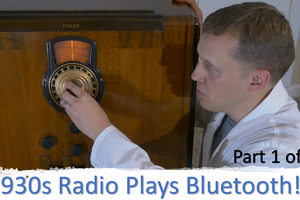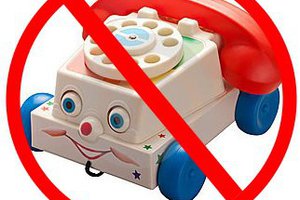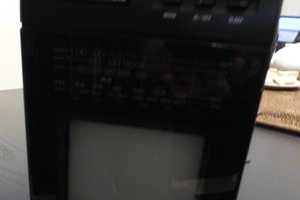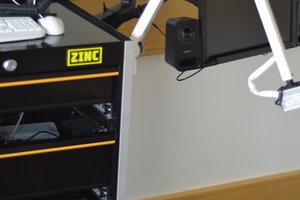I have a very nice 15-inch colour portable Toshiba TV that accepts PAL and NTSC video standards, which I needed for a project that generated both signals. It is great if you have a colour computer.
For monochrome computers, the colour phosphor matrix is a hindrance, as it breaks the fine lines in text fonts into small coloured sub-pixels. A monochrome display will give higher resolution. I was reluctant to buy another bulky CRT-based gadget, especially as I would only use it occasionally.
Looking through eBay, I found that there many really small (5-inch screen) black-and white portables. These were mass produced when someone created a single-chip monochrome TV and radio chip. I imagine they were popular with kids going to university, campers, and so on.
Since analogue TV transmission has been turned off, these TVs are now sold on eBay fairly cheaply. Sometimes the postage costs more (about £7).
They all seem to be based on the same TV controller chip, so the circuits are very similar. Once you have seen which pin is the baseband video signals from the tuner, it is simple to route a bit of co-ax cable to a co-ax connector. You will have to drill a hole for this.
The only important things are to wear protective goggles just incase the tube breaks and implodes. If glass splinters get in your eyes, you can imagine how painful that is. Secondly, even a small tube uses thousands of volts to hurl electrons into the phosphor screen. The tube itself has some capacitance and will store high-voltage charges for some time after you have switched it off. I don't know how long exactly, but if your mods do not work first time then don't open it up straight away and start poking around in it.
I've modified several TVs like this. A couple didn't work but I'm pretty sure they were not working to begin with. In the absence of UHF broadcasts, I can't check they work with the tuner signal first.
There is usually a switch that powers either the TV or the radio. You can modify this so the TV is always on and you can switch the radio on if you want to listen to that. However, it isn't great quality sound. The ZX80/81 was designed before strict EMC regulations, so the radiated RF will add noise to the radio signal.
The battery compartment takes ten 'C' size cells. If you just power stuff from a 12V adapter, you can use the compartment for project boards. For example, you could fit a Raspberry Pi running a ZX81 emulator in there.
Picture quality is not outstanding, because nobody was going to put advanced TV circuitry in a product designed to be cheap. The screen is curved, and the dynamic range is not great. However it is great for monochrome video from old computers. Text is readable, and certainly better than on a colour tube.
Most importantly for me, they don't take up much storage space.
2018-05-06 I am rather surprised that this project is liked about ten times more than any of my other projects, which are far more technical. Perhaps the more general purpose something is, the wider the appeal?
I've also noticed the letters on the left side of the screen seem to be a little wider than those on the left. I guess it would not bother the casual viewer would would have just been glad to get any television in their student bedroom. I should write a test-card program to check the geometric distortion.
2020-06-05
I saw all these tiny tellies had disappeared from eBay television section, and thought the global stock had either been sold or thrown away, but they now appear under Collectables > Radio, Television & Telephony > Television Sets
 Keith
Keith
 W. Jason Altice
W. Jason Altice
 jeremy.darling
jeremy.darling
 Maciej Witkowiak
Maciej Witkowiak
Sound good. Is it possible to test or connect with modern LCD? I want to test for my device, you can see here my project detail https://www.bestreviewsbox.com/change-hz-on-monitor/